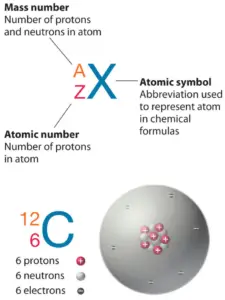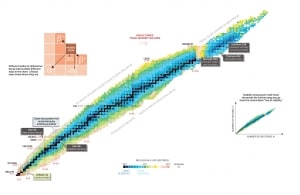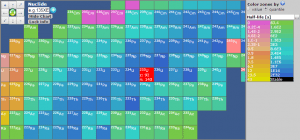Number Of Protons In Uranium
Diminutive number or proton number is defined as the total number of protons in the nucleus. The number of electrons in an electrically-neutral atom is the same equally the diminutive number. Material Properties
Diminutive Number

The atom consist of a pocket-sized simply massivenucleussurrounded by a deject of rapidly movingelectrons. The nucleus is composed ofprotons and neutrons. The total number of protons in the nucleus of an cantlet is called the atomic number (or the proton number) of the atom and is given the symbol Z.
The number of electrons in an electrically-neutral atom is the same as the number of protons in the nucleus. The total electrical charge of the nucleus is therefore +Ze, where eastward (elementary accuse) equals toone,602 x 10-19coulombs. Each electron is influenced by the electric fields produced past the positive nuclear accuse and the other (Z – 1) negative electrons in the atom.
Since the number of electrons is responsible for the chemical bavavior of atoms, the diminutive number identifies the diverse chemical elements.
The chemic backdrop of the atom are determined by the number of protons, in fact, past number and arrangement of electrons. The configuration of these electrons follows from the principles of quantum mechanics. The number of electrons in each element's electron shells, particularly the outermost valence shell, is the primary gene in determining its chemic bonding behavior. In the periodic table, the elements are listed in order of increasing atomic number Z.
Hydrogen (H), for example , consist of one electron and one proton. The number ofneutronsin a nucleus is known as theneutron number and is given thesymbol North. The total number of nucleons, that is, protons and neutrons in a nucleus, is equal toZ + N = A, where A is called themass number. The diverse species of atoms whose nuclei comprise particular numbers of protons and neutrons are chosennuclides. Each nuclide is denoted by chemic symbol of the chemical element (this specifies Z) with tha diminutive mass number as supescript.
Thus the symbol1H refers to the nuclide of hydrogen with a single proton as nucleus.2H is the hydrogen nuclide with a neutron as well as a proton in the nucleus (2H is also called deuterium or heavy hydrogen). Atoms such as1H,2H whose nuclei comprise the aforementioned number of protons merely different number of neutrons (different A) are known asisotopes.
Atomic Number and Nuclear Stability

Nuclear Stability is a concept that helps to place the stability of an isotope. To identify the stability of an isotope it is needed to notice the ratio of neutrons to protons. To determine the stability of an isotope yous tin can apply the ratio neutron/proton (N/Z). Also to help empathize this concept there is a chart of the nuclides, known every bit a Segre chart. This nautical chart shows a plot of the known nuclides as a function of their atomic and neutron numbers. It can be observed from the chart that at that place aremore neutrons than protons in nuclides withZ greater than about 20 (Calcium). Theseactress neutrons are necessary for stability of the heavier nuclei. The excess neutrons act somewhat like nuclear glue.
See also: Livechart – iaea.org

Atomic nuclei consist of protons and neutrons, which concenter each other throughthe nuclear forcefulness, while protons repel each other viathe electric strength due to their positive charge. These two forces compete, leading to diverse stability of nuclei. There are only certain combinations of neutrons and protons, which formsstable nuclei.
Neutrons stabilize the nucleus, because they attract each other and protons , which helps first the electrical repulsion betwixt protons. As a result, as the number of protons increases,an increasing ratio of neutrons to protons is needed to form a stable nucleus. If there are also many or too few neutrons for a given number of protons, the resulting nucleus is not stable and it undergoes radioactivity.Unstable isotopesdisuse through diverse radioactive decay pathways, almost normally alpha decay, beta decay, or electron capture. Many other rare types of decay, such as spontaneous fission or neutron emission are known. It should be noted that all of these decay pathways may exist accompanied bythe subsequent emission of gamma radiation. Pure alpha or beta decays are very rare.
Atomic Number – Does it conserve in a nuclear reaction?
In full general, the atomic number is not conserved in nuclear reactions.
In analyzing nuclear reactions, we apply themany conservation laws.Nuclear reactions are subject to classicalconservation laws for accuse, momentum, athwart momentum, and energy(including rest energies). Boosted conservation laws, not anticipated by classical physics, are areelectric charge,lepton number and baryon number. Certain of these laws are obeyed under all circumstances, others are non. We have accustomed conservation of energy and momentum. In reactor physics (non-relativistic physics), nosotros presume that the number of protons (the atomic number), the number of neutrons (the neutron number) and its sum (the atomic mass number) are usually separately conserved. We shall find circumstances and atmospheric condition in which this dominion is not truthful. Where we are because non-relativistic nuclear reactions, it is essentially true. All the same, where nosotros are because relativistic nuclear energies or those involving the weak interactions(e.g. in beta decay the atomic number is not conserved), nosotros shall notice that these principles must be extended.
Conservation of Electrical Accuse
As was written, the total electrical charge of the nucleus is determined by the atomic number and is equal to+Ze. Conservation of charge is thought to be auniversal conservation law. No experimental evidence for whatsoever violation of this principle has ever been observed.
For example:
Consider atypical fission reaction such as the ane listed beneath.

Typically, whenuranium 235 nucleus undergoes fission, the nucleus splits into two smaller nuclei (triple fission tin can also rarely occur), along with afew neutrons (the boilerplate is two.43 neutrons per fission by thermal neutron) and release of energy in the form of heat and gamma rays. From these reactions we discover that in the fission the parent nucleus:
- 235U contains 92 protons (a accuse of +92e),
- incident neutron is electrically neutral.
The fission fragments:
- 139Ba contains 56 protons (a charge of +56e),
- 94Ba contains 36 protons (a accuse of +36e)
We run across that the total charge is 92e before and later the reaction; thus, charge is conserved. It is noteworthy, the total number of nucleons before and after a reaction are likewise the same.
Loftier Diminutive Number Materials Use – Shielding of Gamma Radiation

In brusk, effective shielding of gamma radiation is in most cases based on utilize of materials with two following cloth properties:
- loftier-density of fabric.
- high atomic number of material (high Z materials)
However, low-density materials and low Z materials can be compensated with increased thickness, which is every bit significant as density and atomic number in shielding applications.
A atomic number 82 is widely used every bit a gamma shield. Major advantage of lead shield is in its firmness due to its higher density. On the other hand depleted uranium is much more effective due to its higher Z. Depleted uranium is used for shielding in portable gamma ray sources.
In nuclear power plants shielding of a reactor core can be provided past materials of reactor pressure vessel, reactor internals (neutron reflector). Also heavy concrete is usually used to shield both neutrons and gamma radiation.
Although h2o is neither high density nor high Z material, it is commonly used as gamma shields. Water provides a radiation shielding of fuel assemblies in a spent fuel puddle during storage or during transports from and into the reactor core.
Atomic Number Density
Atomic number should not be dislocated with the diminutive number density, which completely unlike concrete quantity.
In nuclear physics, themacroscopic cross-section represents theeffective target area of all of the nuclei independent in the book of the material. Themacroscopic cross-section is derived frommicroscopic cantankerous-departmentand thediminutive number density (N):
Σ=σ.Due north
In this equation, theatomic number density plays the crucial function every bit the microscopic cantankerous-section, because in the reactor cadre the atomic number density of certain materials (e.grand. water as the moderator) can exist simply changed leading into certainreactivity changes. In social club to sympathize the nature of thesereactivity changes, nosotros must empathize the term the atomic number density.
The atomic number density (N; atoms/cm3) is the number of atoms of a given blazon per unit volume (V; cm3) of the fabric. The atomic number density (Due north; atoms/cm3) of a pure fabric havingatomic or molecular weight (M; grams/mol) and thematerial density (⍴; gram/cm3) is hands computed from the following equation using Avogadro's number (Due northA = 6.022×1023 atoms or molecules per mole):

References:
Nuclear and Reactor Physics:
- J. R. Lamarsh, Introduction to Nuclear Reactor Theory, 2nd ed., Addison-Wesley, Reading, MA (1983).
- J. R. Lamarsh, A. J. Baratta, Introduction to Nuclear Engineering, 3d ed., Prentice-Hall, 2001, ISBN: 0-201-82498-one.
- W. M. Stacey, Nuclear Reactor Physics, John Wiley & Sons, 2001, ISBN: 0- 471-39127-1.
- Glasstone, Sesonske. Nuclear Reactor Applied science: Reactor Systems Technology, Springer; quaternary edition, 1994, ISBN: 978-0412985317
- Due west.S.C. Williams. Nuclear and Particle Physics. Clarendon Press; ane edition, 1991, ISBN: 978-0198520467
- G.R.Keepin. Physics of Nuclear Kinetics. Addison-Wesley Pub. Co; 1st edition, 1965
- Robert Reed Burn, Introduction to Nuclear Reactor Operation, 1988.
- U.S. Department of Energy, Nuclear Physics and Reactor Theory. DOE Fundamentals Handbook, Book 1 and two. Jan 1993.
- Paul Reuss, Neutron Physics. EDP Sciences, 2008. ISBN: 978-2759800414.
Advanced Reactor Physics:
- K. O. Ott, West. A. Bezella, Introductory Nuclear Reactor Statics, American Nuclear Club, Revised edition (1989), 1989, ISBN: 0-894-48033-2.
- K. O. Ott, R. J. Neuhold, Introductory Nuclear Reactor Dynamics, American Nuclear Society, 1985, ISBN: 0-894-48029-four.
- D. L. Hetrick, Dynamics of Nuclear Reactors, American Nuclear Club, 1993, ISBN: 0-894-48453-2.
- E. E. Lewis, W. F. Miller, Computational Methods of Neutron Send, American Nuclear Society, 1993, ISBN: 0-894-48452-iv.
See also:
Nuclear Structure
We hope, this commodity, Atomic Number, helps you. If then, give usa a like in the sidebar. Main purpose of this website is to help the public to acquire some interesting and important information about materials and their properties.
Number Of Protons In Uranium,
Source: https://material-properties.org/what-is-atomic-number-definition/
Posted by: brownfrophe.blogspot.com


0 Response to "Number Of Protons In Uranium"
Post a Comment